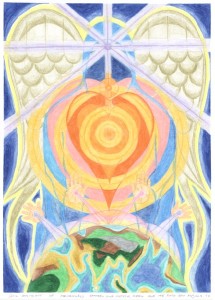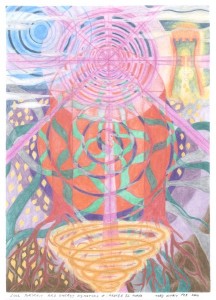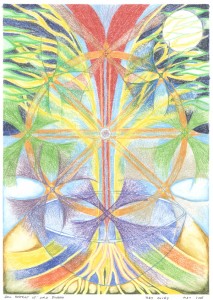In my last article I write about the validity of including the experiences of attraction and desire in our experience of love and in particular our romantic relationships. In these articles I am breaking romantic love goes up into four stages:
- The first stage is attraction and desire
- The second stage is relationship
- The third stage is union
- The fourth stage is creativity
Each of these four stages can happen in five types of romantic relationship:
- The inner romance between the soul and personality
- The romance between ourself and the divine
- The romance between two humans (or two evolved life forms, I guess you could include some animals and some nature devas in this bracket too)
- The romance we can experience between ourself and landscape, or sense of place
- The romance between ourself and our “art” or the work that we love.
So, after the initial intensity of attraction and desire (which is a natural and enjoyable phase of romantic love) has started to fade, what happens then? The answer is we move to the next stage, which I have termed “relationship”. This starts to emerge when:
With a lover:
- You no longer see the person that you are engaged in a romance with through an idealized projection. It starts to become obvious that the person you are with is not perfect. He or she has faults and eccentricities that you were previously prepared to gloss over and “not see”, but now there they are in plain sight.
- It is an effort to control your ego in your interaction with your partner. When filled with attraction and desire for him/her, the ego was prepared to take a back seat, but now the novelty of the romance has worn off, your ego come back, and starts to act as crankily and grumpily as ever
- The first obvious arguments and disagreements occur
- You start thinking “Is this person as right for me as I thought s/he was?”
- Issues cannot be resolved simply by having sex or schmoozing
With our soul and the divine: (I will place the two of these together here in the context of, let’s say a daily meditation practice)
- Our initial awakening or expansion of consciousness becomes the norm, the novelty wears off
- We start to wonder if the sense of connection and oneness that we previously felt was real. Maybe it was an illusion
- All that is not oneness, not love, not peace starts to re-emerge in our mind
- We become intensely aware of all the parts of our mind that our broken, hurt or otherwise suffering or in pain
- Meditation becomes “work” no longer effortless play
- The complexity, cruelty, difficulty, negativity of our world comes back into focus with a jolt
With landscape or sense of place:
- The novelty of the new place becomes ordinary, we start to see the dirt on the sidewalk rather than the beauty of the overall ambiance
- Our daily routine in the new place becomes effortful
- We realize the damage that may have been done to the place or environment, and the amount of work that we will have to do to heal or restore the landscape
With our art or work:
- When the initial enthusiasm for the discipline that we have been attracted to dies
- We have our first few technical setbacks, it is going to be more complicated that we thought!
- We have to face our work or art being critiqued (positively or negatively) by others
- As Michelangelo said: “If people knew how much work it took to make my art, they would not think it so beautiful!”
So, what to do when this starts to happen?
Here are a few suggestions:
- Recognize what is happening in your romance is a natural part of its unfolding. If it is going to flower into the stages of union and creativity, then it has to go through this testing phase of relationship
- Know that the tools that will help you at this stage are things like tenderness, honesty, love and compassion (for self and others equally), integrity, a wiling-ness to see the unpleasant without blinking.
- Don’t mourn the loss of the initial bliss of desire and attraction! If you persevere with the relationship stage desire and attraction will re-emerge in your relationship in the deeper, creative forms of passion and ecstasy (another good word for ecstasy might be rapture)
- Recognize that the emphasis in your romance has shifted from a temporarily pleasurable phase to a phase of deeper healing, confrontation and self-enquiry (mutual self enquiry if with a person)
- Understand this is a phase that will require effort, mindfulness, consistency and devotion
- Don’t be attached to quick results, the challenges in this phase can last years, even decades
- Don’t be afraid of dark times; true, non-idealized love is a treasure hard won!
- This phase of the romance will test you to see whether the person, work, place or spiritual practice really is right for you. Whilst recognizing that work will be involved to make the relationship succeed, sometimes the work reveals that the relationship is not in fact right for you. If so, be prepared to let go. The best one liner I ever heard for this is from the Zen Roshi DT Suzuki “In relationships is it not a matter of letting go of what is there, but rather recognizing what has already gone”. You know if a relationship is over because it has already gone.
Contemplation on developing a devotion to your romantic relationships:
Consider any of your romantic relationships with any of the five types of object above. Think about the difficulties that you face, the things about it that you fear, hate, find tiresome etc…Allow yourself to feel the reality of the challenges, and the emotions that you feel.
When you have done this, then focus on developing a mind of devotion to the relationship. Devotion is a mind that has the patience, endurance and love to see the difficulties in your relationship through to their successful resolution.
Simply sit and breathe with your devotion for a while, allow it to strengthen your resolve to build a romantic relationship based around deep love, not just changeable pleasure. Know that if you follow this devotion it will lead you on the long term path to bliss and romantic fulfillment.
© Toby Ouvry 2010, you are welcome to use this article, but you must seek Toby’s permission first! Contact info@tobyoury.com


